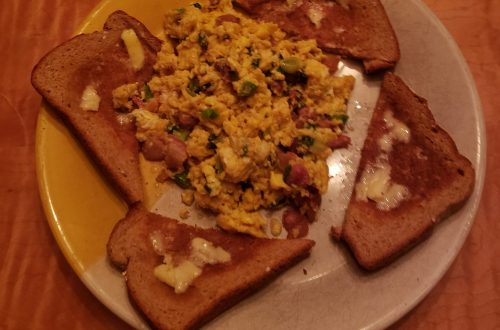
The Wide World of Curry
When most Americans think of Indian food, they usually think of well-known curry dishes such the chicken tikka masala pictured above – rich, creamy sauces, a variety of spices, served with naan bread. But in Britain, curries come in countless varieties and are wildly popular. In fact, England just celebrated National Curry Week.
Curries are prized the world over: katsu curry in Japan, chicken and coconut curry in Kenya, and curry wursts in northern Europe. Though Americans typically associate the dish with India, it’s truly an international dish that has evolved over the past several hundred years. Yes, it originated in India, but it has evolved and transformed over time since it was first created by the Indus Valley civilization as early as 2000 BC. These cooks used a mortar and pestle to blend spices such as cumin, fennel, and tamarind pods to mix them with their food. The name curry comes from the Tamil word “kari” meaning a sauce or relish for rice.
When Europeans began voyages to Asia, they were often seeking spices. In India, the Portuguese were among the first to explore the cuisine in the 1490s. Combining their pork with garlic dish with local spices, they produced what we now know as vindaloo. A Dutch traveler’s account in the late 1500s described the local fish as cooked in broth then put on rice and called “carriel.” Meanwhile, tomatoes, peppers, and potatoes that Europeans brought from the New World made their way to India, and the peppers, in particular, were used as additional spice accompaniment to the local kari.
Currying flavor
When it comes to curry, it was the Brits who took over much of India and came to enjoy the local cuisine. The Oxford Companion to Food says that when the British returned to England from India, they wanted to continue to make those dishes, so they created a commercial ready-mixed curry powder that reflected (usually) the mixture used back in India. Elsewhere in the world, Chinese curry probably came to the British Isles via Malay Chinese, while Japanese curry was adopted during the Meiji period when Japan looked outward for the first time.
These days, Britain has a curry house in almost every town and calls curry its “adopted national dish.” That’s about 12,000 curry houses employing some 100,000 people serving a savory, spiced dish that is adapted to British tastes. The first known British recipe was a 1747 instruction by Hannah Glasse for a stew of fowls or rabbits with a spoonful of rice and peppercorns and coriander. The Oxford Companion explains that what had been an Indian sauce to go with rice had become an English stew with rice in it.
Like many national spice combinations around the world, the traditional South Indian kari does not have a fixed set of ingredients. Rather, it’s a combination of roasted curry leaf, coriander, cumin, mustard seeds, red and black pepper, fenugreek, turmeric, and sometimes cinnamon, cloves, and cardamom, all ground into a powder. The Brits (or “nabobs” as they were known in India), ever inventive, managed to adopt a number of Indian dishes. Indian Chef Palak Patel explained that “kajeri,” a popular British egg dish of rice and smoked salmon, transformed into a vegetarian dish of lentils and rice called kitchari. And mulligantany, a Tamil word meaning pepper water, was originally a cure for digestion issues, then adopted by Indian cooks and rechristened mulligatawny, a soup with vegetables and spices for the nabobs.
Spicing it up
These days, British curries are derived partly from India and partly from invention in local Indian restaurants that might not even be recognized back in India. Mild curries such as korma are creamy and may contain almonds, coconut, or fruit, while medium-hot curries such as madras are inspired by Bangladeshi restaurants and are typically red and spicy from chili powder. Hot curries such as a vindaloo, also inspired by Bangladeshi chefs, are usually very spicy with chili peppers and potatoes. You may also find extremely spicy curries such as phail made with scotch bonnet or habañero peppers. The Brits even have a make-ahead curry sauce to be used any time there are leftover meats.
Americans seem to be catching up. We have more and more local Indian restaurants that have spurred cooks to mimic the recipes. Now, we have our own butter chicken and tikka masala dishes. And maybe the National Curry Week will spread here.
From your email, please click on the headline to view the blog and photo on the website. You can log in and comment at the end of the blog to share your thoughts and start a discussion, or suggest a topic for Farmboy in the Kitchen.
If you’d like to share the blog, click on the Facebook icon or one of the others. Thanks!




